Home Decor
You Won’t Believe What Batik Can Do for Your Home’s Style
You’ll discover how batik can transform your home’s style with vibrant patterns and colors that leave a lasting impression. What creative possibilities await?

You won't believe how batik can elevate your home's style! This unique fabric-dyeing technique offers vibrant colors and intricate patterns that add cultural depth to your decor. Whether it's bold wall hangings, stylish throw pillows, or elegant table runners, batik infuses warmth and character into any space. You'll find it complements various design styles, from modern to bohemian. Plus, choosing batik supports traditional artisans and sustainable practices. By incorporating these stunning pieces, you can transform your home into a vibrant tapestry of artistry. Curious about more creative ways to use batik in your decor? There's plenty more to explore!
Key Takeaways
- Batik fabric adds unique artistic flair to your home, enriching its overall aesthetic with vibrant colors and intricate patterns.
- Incorporating batik through throw pillows and wall hangings creates stunning focal points that enhance any room's character and warmth.
- Batik's eco-friendly attributes, especially with natural dyes, appeal to sustainable consumers looking for environmentally conscious decor options.
- Versatile in style, batik complements various decor themes, including modern, bohemian, and eclectic, promoting a culturally rich atmosphere.
- Using batik table runners and curtains beautifully enhances dining areas and windows, combining functionality with artistic expression in your home.
What Is Batik?
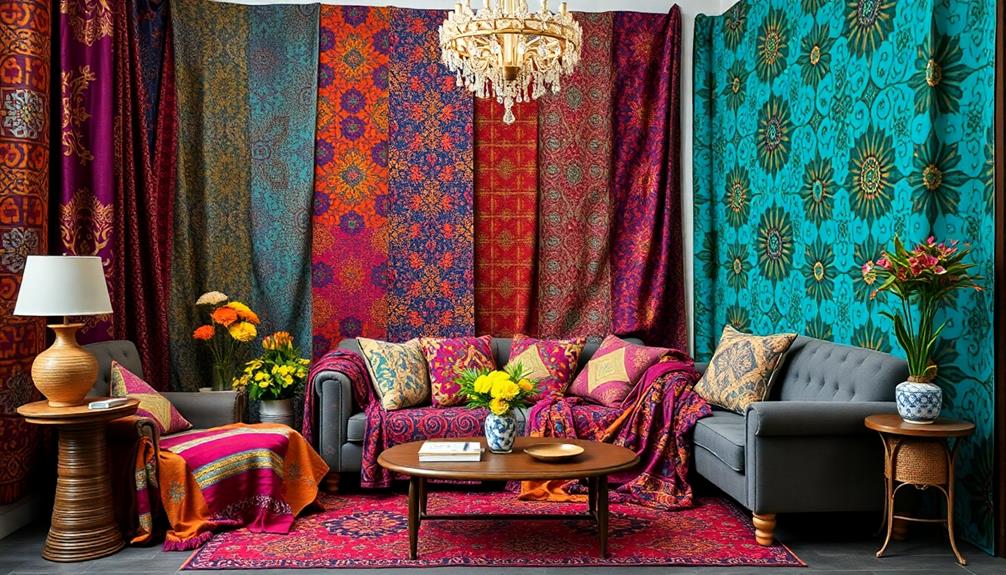
Batik's rich tradition stems from Indonesia, showcasing a unique fabric dyeing technique that combines artistry and craftsmanship. The batik process involves applying wax to fabric, creating intricate patterns through a resist dyeing method.
You'll find that artisans use various types of wax, primarily paraffin and beeswax, to block dye absorption in specific areas, resulting in stunning visual effects. This exceptional technique is similar to the craftsmanship seen in traditional Indonesian decor masks, which also reflect the country's cultural heritage through intricate designs and vibrant colors.
What sets true batik apart is that it features the same color on both sides of the fabric, highlighting the skill involved in its creation. This is a significant distinction from printed fabrics, which lack that depth and craftsmanship.
When you explore the batik-making process, you'll see it can take weeks to finish, as artisans engage in multiple dye baths and carefully remove the wax to reveal the final design.
Tools like the tjanting allow for precise wax application, while brushes can create broader effects.
The History of Batik

Batik's roots trace back over a thousand years in Indonesia, where it emerged as a vibrant expression of cultural identity.
This traditional artistry is deeply intertwined with local customs, much like the vibrant artistry of Indonesian decor masks.
You'll notice how the techniques have evolved, with artisans mastering the art of applying wax to create stunning patterns.
Each design tells a story, reflecting the rich traditions and messages unique to the region.
Cultural Origins of Batik
For over a thousand years, people in Indonesia have been perfecting the art of batik, a traditional fabric dyeing technique that employs wax to create stunning patterns. This intricate craft isn't just a method of textile production; it carries deep cultural significance and reflects the rich heritage of Indonesian communities.
Each region boasts its own unique styles and motifs, often telling stories of local history and identity. Batik is often used in Indonesian Decorative Pillows, adding vibrant colors and intricate patterns that enhance living spaces. Imagine the vibrant scenes that batik can evoke in your home:
- Intricate Designs: Each piece tells a story through its patterns, showcasing the craftsmanship of generations.
- Cultural Heritage: Batik represents a living tradition, connecting you to Indonesia's past and present.
- Unique Decor: Incorporating batik into your space adds an authentic touch that sets your style apart.
In 2009, UNESCO recognized batik as a Masterpiece of the Oral and Intangible Heritage of Humanity, further underscoring its importance.
As you explore batik for your home, you'll discover a beautiful blend of artistry and history that enriches your living space while honoring its traditional roots.
Evolution of Techniques
The rich heritage of batik isn't static; it has transformed over centuries, adapting to cultural shifts and technological advancements. Originating in Indonesia, batik techniques date back to ancient times, showcasing intricate designs created through a resist dyeing process using hot wax.
As you explore a batik project, you'll discover that traditional techniques often involve a tjanting tool, which allows artisans to apply wax precisely, resulting in detailed patterns unique to various regions. Additionally, batik often reflects the cultural narratives and artistry seen in other Indonesian handicrafts, such as Indonesian decor masks, enriching the storytelling aspect of the art form.
Over time, batik has embraced modern materials and dyes. The introduction of synthetic dyes in the 19th century broadened the color palette, enabling artists to create more vibrant and varied designs than the natural dyes used previously.
Despite these advancements, many artisans continue to honor traditional techniques, preserving the artistry and cultural significance of batik.
Today, batik techniques are celebrated globally, inspiring contemporary artists and home decor trends. As you engage with batik, through educational workshops or community efforts, you help keep this beautiful tradition alive while adding a distinct touch to your home's style.
Embrace the evolution of batik and let its rich history elevate your space.
Benefits of Batik for Home Decor
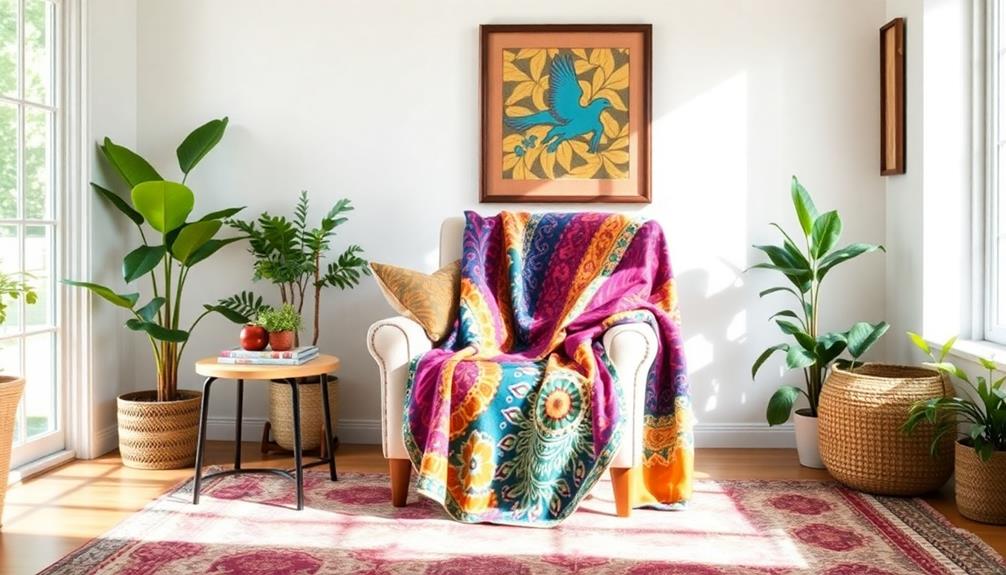
While many home decor options offer style, batik fabric stands out by adding a unique and artistic touch that reflects cultural heritage. By incorporating batik into your home, you not only enhance the aesthetic but also tell a story through intricate designs and craftsmanship.
The vibrant colors and patterns of batik can beautifully complement the natural materials and earth tones found in Balinese interior design concepts, creating a harmonious environment that promotes relaxation and tranquility.
Here are some benefits of using batik in your home decor:
- Vibrant Upholstery: Transform your furniture with batik fabric, bringing colors and textures that complement modern or traditional styles.
- Eye-Catching Wall Hangings: Batik wall hangings serve as focal points in any room, making your space more inviting and personalized.
- Eco-Friendly Choice: Opting for batik, especially those made with natural dyes, aligns with sustainable practices, appealing to environmentally conscious consumers.
Incorporating batik into textiles like cushion covers and table runners enhances your living space's visual appeal, creating a cozy atmosphere.
Batik Techniques and Styles
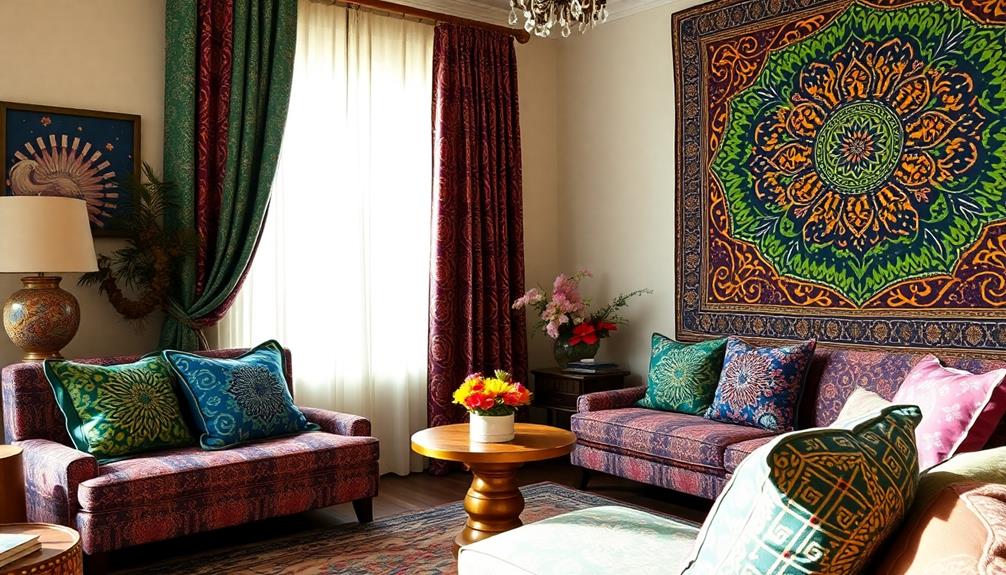
When you explore batik techniques, you'll find a rich blend of traditional methods and modern applications.
Traditional batik relies on wax application and intricate designs, while contemporary styles often embrace innovative uses of this art form.
Incorporating batik into your home decor can beautifully complement luxury tropical designs and create a unique aesthetic.
Understanding these techniques can inspire you to incorporate batik into your home decor in fresh and exciting ways.
Traditional Batik Methods
In traditional batik methods, artisans skillfully apply a resist dyeing technique using wax to create intricate patterns on fabric. This process begins with tracing designs onto the fabric, followed by the careful application of wax using a tjanting tool or brushes. The tjanting's copper cup allows for precise wax application, while brushes enable broader strokes for more extensive designs.
The artistry of batik reflects traditional Indonesian style home decor, showcasing the rich cultural heritage and craftsmanship behind each piece.
Consider these elements of the batik process:
- Dual wax types: Paraffin adds stiffness and crackle effects, while beeswax allows for smoother line work and intricate details.
- Dyeing baths: The dyeing process involves multiple baths, starting with lighter colors and moving to darker shades, creating complex layering and rich color combinations.
- Wax removal: After dyeing, artisans remove the wax by boiling or ironing, ensuring the fabric retains its softness and vibrancy.
Through this meticulous process, you can appreciate the artistry and dedication that goes into creating stunning batik designs, making them a beautiful addition to your home style.
Traditional batik not only showcases elegance but also tells a story through its intricate patterns.
Modern Batik Applications
Modern batik applications have taken off, bringing this traditional art form into contemporary home design. You can find modern batik techniques using a variety of fabrics like cotton, silk, and even synthetic materials, making them perfect for diverse home decor choices.
With pre-mixed batik wax, artists can create intricate designs that pop with vibrant color effects, adding life to your living spaces. The incorporation of batik textiles can also reflect traditional Indonesian housing styles, showcasing the rich cultural heritage inherent in these designs.
Advanced styles often involve multiple dye baths and resist techniques, allowing for stunning layered color combinations. Think about incorporating batik textiles like curtains and cushions that enhance your home's aesthetic. These elements not only beautify your space but also serve as unique focal points that showcase the craftsmanship and cultural significance of batik.
Contemporary batik artists are pushing boundaries, experimenting with non-traditional patterns and innovative color palettes. This versatility means you can find batik pieces that align perfectly with your personal style, whether you prefer bold and vibrant or subtle and understated.
Incorporating Batik Into Your Space
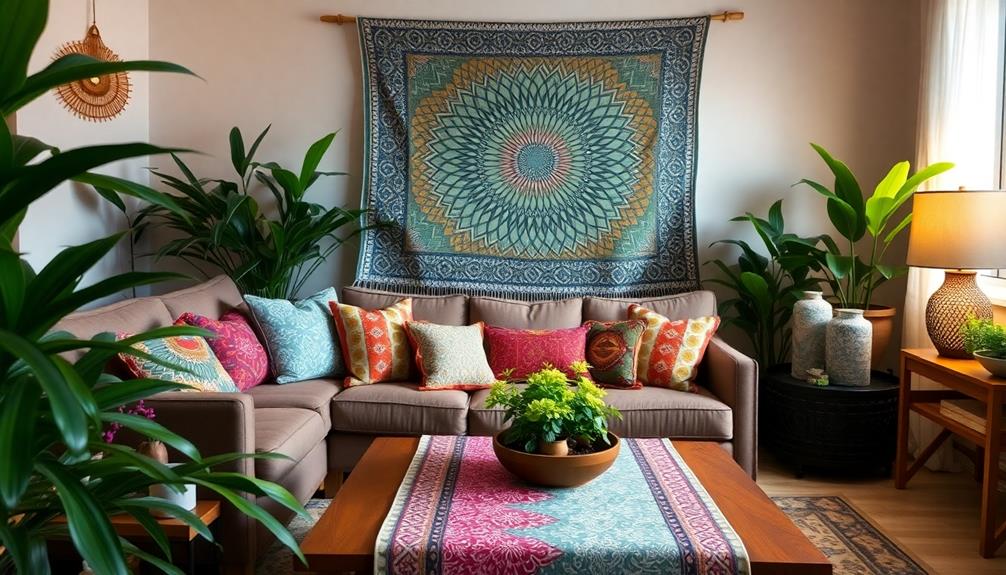
Batik can effortlessly elevate your home's style, turning everyday spaces into vibrant showcases of culture and artistry. By incorporating batik into your home decor, you not only enhance the aesthetics but also promote appreciation for traditional craftsmanship.
The unique designs and vibrant colors of batik fabric can add character and warmth to any room, creating an inviting atmosphere that draws people in. Additionally, batik can harmonize beautifully with tropical villa plans, emphasizing open spaces and natural light.
Consider these ideas for incorporating batik into your space:
- Throw Pillows: Add a pop of color to your sofa with batik-patterned cushions that invite comfort and conversation.
- Table Runners: Dress your dining table with a stunning batik runner, offering a striking contrast to neutral tableware and enhancing the dining experience.
- Wall Hangings: Showcase batik art on your walls, turning them into a gallery that tells stories of heritage and artistry.
With such versatility, batik can seamlessly complement your existing decor style, whether it's modern, minimalist, bohemian, or eclectic.
Embrace the beauty of batik and transform your home into a vibrant haven of unique designs and cultural significance.
Care and Maintenance of Batik Fabrics
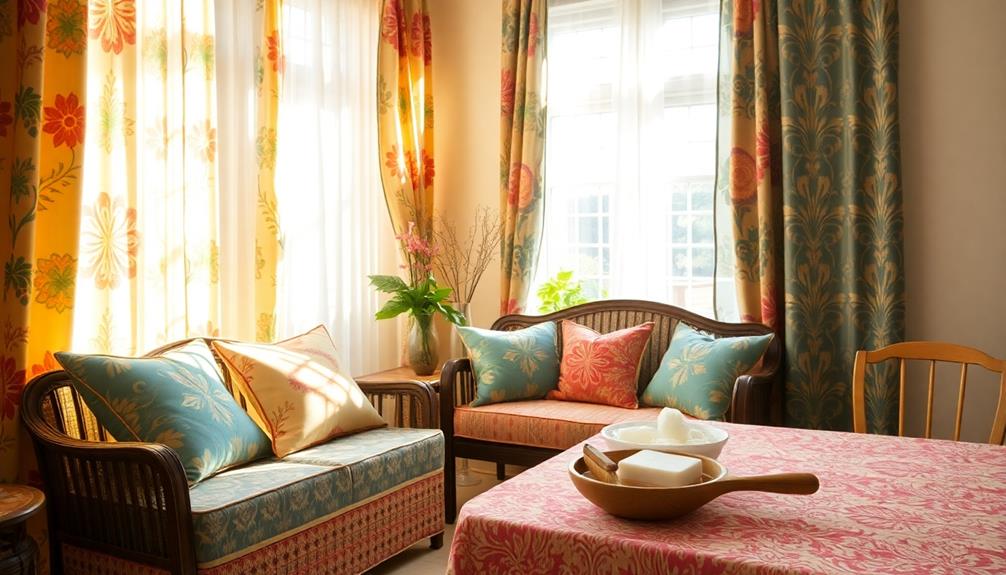
To keep your batik fabrics looking their best, it's essential to follow some straightforward care guidelines.
Start by hand washing your batik in cold water with a mild detergent. This helps preserve the intricate designs and vibrant colors. Avoid using bleach or harsh chemicals, as they can severely fade the colors and weaken the fabric over time.
When drying your batik, hang or lay it flat away from direct sunlight. Sunlight can cause the beautiful colors to fade, diminishing the fabric's appeal.
For maintenance, when it's time to iron, use a low to medium heat setting. Always place a cloth between the iron and the fabric to protect the wax-resist areas from direct contact.
Storage is equally important. Keep your batik items in a cool, dry place, preferably wrapped in cotton or acid-free tissue paper. This prevents creasing and protects against moisture and pests.
DIY Batik Projects for Home

After caring for your batik fabrics, why not take your creativity a step further with DIY batik projects? These projects allow you to add unique, vibrant patterns to your home décor, showcasing intricate designs that reflect cultural artistry.
Incorporating traditional motifs and patterns can enhance the cultural significance of your creations. You can use a combination of paraffin and beeswax to create stunning effects, and the results will be one-of-a-kind! With vibrant colors and floral arrangements, your batik decor can truly elevate the ambiance of your space traditional motifs.
Here are a few ideas to get you started:
- Wall hangings: Transform a blank wall into a canvas of color.
- Decorative table runners: Bring life to your dining table with beautiful patterns.
- Cushion covers: Create cohesive aesthetics throughout your living space.
To begin, you'll need to melt the wax and carefully apply it to the fabric before you dye the cloth with Procion dye. The wax removal process, once the dye has set, will reveal your intricate designs.
By layering wax and dye, you can achieve complex color effects that make each piece truly special. Engaging in these projects not only enhances your style but also promotes sustainability by reusing materials creatively.
Batik vs. Other Textile Arts

When you compare batik to other textile arts, the unique design techniques truly stand out.
The meticulous use of wax in batik not only creates intricate patterns but also carries deep cultural significance that many other methods lack.
Understanding these differences can help you appreciate the artistry behind batik and its role in diverse cultures.
Unique Design Techniques
Batik stands out among textile arts due to its intricate and deliberate design techniques that set it apart from methods like screen printing or tie-dye. With batik, you experience a unique artistry that combines precise planning and creativity, resulting in stunning fabric that tells a story.
- Layering Wax: Batik artists skillfully apply layers of wax to create complex patterns and textures, allowing for a rich depth that other techniques can't achieve.
- Dye Techniques: The process involves multiple dye baths, enabling vibrant color combinations that transform fabric into a visual masterpiece.
- Unique Designs: Each piece of batik is one-of-a-kind, thanks to the wax-resist method, which prevents dye from reaching certain areas, resulting in intricate, detailed imagery.
Unlike tie-dye's random patterns, batik offers a structured approach, where the wax acts as a barrier, leading to exceptional detailing.
The use of both paraffin for stiffness and beeswax for flexibility allows artists to manipulate textures, making batik a distinctive form of textile art.
When you incorporate batik into your home, you're not just decorating; you're embracing a rich tradition of unique designs. Embracing these traditional designs adds a sense of cultural depth and history to your living space. With batik home decor ideas, you can create a warm and inviting atmosphere that reflects the artistry and craftsmanship of this ancient technique. From throw pillows to wall hangings, incorporating batik into your home allows you to showcase the beauty of this time-honored craft.
Cultural Significance Comparison
Textile arts around the world carry deep cultural significance, and batik is no exception. This traditional Indonesian fabric dyeing technique stands out with its intricate resist designs created using wax, unlike other methods like tie-dye, which simply involves knotting fabric. True batik showcases the same color on both sides, highlighting its craftsmanship and the importance of preserving heritage.
Batik serves as a unique storytelling medium, reflecting historical narratives and local traditions. Each piece tells a story, much like tapestry weaving in various cultures.
While batik has gained global recognition, influencing contemporary textile arts and home decor, it remains rooted in its cultural origins. This contrasts sharply with synthetic and mass-produced textile arts, which often lack depth.
Philosophically, batik embodies a strong connection to community and identity, similar to Japanese shibori and Indian block printing. These textile arts also carry rich cultural meanings, celebrating their respective histories and techniques.
Sources for Quality Batik Fabrics
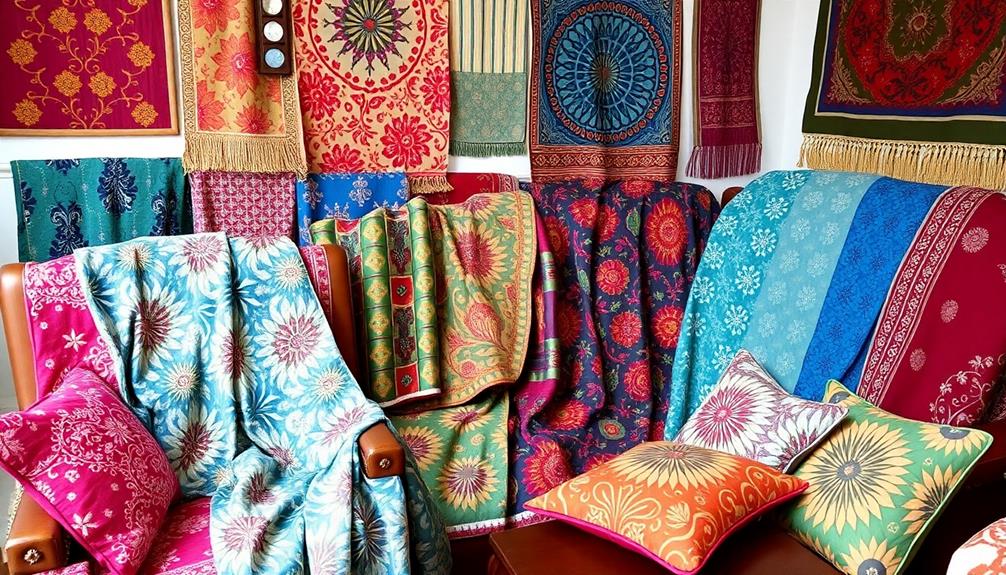
Finding quality batik fabrics can transform your home decor with their vibrant colors and intricate designs. Sourcing these fabrics involves looking for artisans who uphold traditional craftsmanship, particularly from regions like Indonesia.
Here are some tips to help you find the best options:
- Check local artisans: They often create unique pieces that reflect authentic techniques.
- Explore specialized fabric shops: These stores usually carry quality batik and support sustainable practices.
- Browse online platforms: Websites like Etsy showcase a variety of options, allowing you to compare patterns and materials easily.
When selecting your batik fabrics, seek those made with a blend of paraffin and beeswax. This combination enhances dye resistance and allows for detailed patterns.
Pay attention to the weight and texture as well; high-quality batik typically has a soft, pliable feel that drapes beautifully, making it ideal for various home decor applications.
By choosing the right sources, you not only enhance your living space but also support artisans who prioritize quality batik and sustainable practices.
Happy decorating!
Inspiring Batik Decor Ideas

Infusing your home with batik decor can create a vibrant and culturally rich atmosphere that captivates the eye.
Start by incorporating batik wall hangings; their intricate patterns can serve as stunning focal points in any room, reflecting a deep cultural heritage. For a quick update, consider adding batik throw pillows. They provide a pop of color and texture, making it easy to refresh your home decor without a complete redesign.
In your dining area, batik fabric shines as table runners or placemats, creating an inviting atmosphere while showcasing the artistry of batik. Not only do they protect your surfaces, but they also elevate your dining experience.
Batik curtains are another fantastic option. They filter light beautifully, offering a soft, artistic touch to your windows while enhancing the overall ambiance of your space.
Frequently Asked Questions
Why Is Batik Declining?
Batik's decline stems from mass-produced textiles offering cheaper options, automation threatening its uniqueness, and synthetic fabrics gaining popularity. You'll notice fewer artisans passing down traditional skills, risking the cultural heritage that batik represents.
Does Batik Have a Wrong Side?
Batik doesn't really have a wrong side. Both sides showcase the intricate designs and colors from the wax-resist dyeing process. This unique feature makes every piece a work of art, rich in cultural significance.
Is Batik Bad for the Environment?
Did you know that traditional batik can produce up to 7,000 liters of wastewater per batch? While batik can harm the environment, many artisans are now adopting eco-friendly practices to reduce their impact.
What Are the 4 Different Ways Batik Can Be Done?
You can explore batik through four main techniques: wax resist, where wax blocks dye; direct application for vibrant designs; tie-dye batik for unique patterns; and crayon batik, perfect for beginners and fun projects.
Conclusion
So, you might think batik is just a fancy fabric, but it's actually a game-changer for your home's vibe. Who knew that a bit of dye and wax could transform your space from drab to fab? Whether you drape it over furniture or hang it as art, batik brings a splash of culture and creativity. So go ahead, embrace the unexpected—your walls will thank you, and you'll be the trendsetter everyone can't help but admire!
Home Decor
The Surprising Feng Shui Furniture Mistakes You’re Probably Making
Are you unknowingly disrupting your home’s energy flow? Discover the surprising Feng Shui furniture mistakes you might be making and how to fix them!

You're likely making subtle Feng Shui furniture mistakes that disrupt your home's energy flow. Blocked doorways can hinder the flow of positive Chi, making it essential to keep them clear. Your bed placement might not be ideal if it's facing the door directly. Cluttered spaces create overwhelm and restrict harmony. You might also find that a distracting desk arrangement affects your focus, especially if it faces a window. Finally, overusing a single color can make your space feel stale. By evaluating these areas, you can enhance your environment for better energy. There's so much more to explore!
Key Takeaways
- Blocked doorways disrupt positive energy flow; ensure pathways are clear for optimal Chi entry.
- Poor bed placement, like feet facing the door, can hinder sleep quality and security.
- Cluttered spaces create overwhelm; regular decluttering enhances harmony and invites calm energy.
- Distracting desk arrangements, such as facing windows, can reduce focus and productivity.
- Overusing a single color may diminish character; mix shades and textures for a balanced aesthetic.
Blocked Doorways

Blocked doorways can greatly disrupt the flow of energy, or Chi, in your home. When doorways are obstructed by clutter or furniture, it hinders the full 90-degree openings that are vital for ideal Feng Shui. This blockage prevents positive energy flow, making it necessary to regularly check for obstructions behind doors.
By ensuring clear pathways, you enhance the entry of Chi energy into your living environment. Additionally, incorporating elements such as traditional artistry in your decor, like Indonesian masks, can further enrich the energy of your space.
Maintaining unobstructed doorways not only promotes better energy flows but also creates a sense of openness and accessibility in your space. You may not realize it, but these Feng Shui mistakes can greatly affect your home's atmosphere.
When your doorways are clear, you invite comfort and liveliness into your life.
Take a moment to assess your home. Are any doorways blocked? If so, clear those paths to allow the positive energy to circulate freely. This simple action can transform the energy in your space, making it feel more inviting and harmonious.
Embrace the power of unobstructed doorways, and watch how your surroundings shift to reflect a more vibrant and positive atmosphere.
Poor Bed Placement

Properly positioning your bed is essential for creating a harmonious bedroom environment. In Feng Shui principles, the way you place your bed can greatly impact your sleep quality and overall well-being. To achieve proper bed placement, consider the following:
1. Commanding Position: Place your bed so you can see the door while lying down, enhancing your sense of security and awareness of opportunities. This aligns with Balinese interior design concepts, which emphasize open spaces that promote a feeling of safety and tranquility, allowing for a restful night's sleep.
natural materials used in Balinese design can also contribute to a calming atmosphere.
2. Avoid the Coffin Position: Don't position your bed with its feet pointing directly out the door, as this can disrupt your sleep.
3. Space on Either Side: Guarantee at least 18 inches of space on both sides of the bed to maintain balance between Yin and Yang energies.
4. Mirror Placement: If moving the bed isn't possible, consider strategically placing mirrors to reflect the view of the door, allowing for a sense of control without compromising space.
Cluttered Spaces

Cluttered spaces can greatly hinder the flow of positive energy, or Chi, in your home. When your environment is filled with excess decorations or furniture, it creates a sense of overwhelm, making your rooms feel smaller and less inviting. This goes against Feng Shui principles that promote open and airy spaces.
To restore balance, focus on decluttering. By regularly removing unnecessary items, you not only enhance the aesthetic appeal but also foster a more harmonious relationship with your surroundings. Incorporating Indonesian decorative pillows with vibrant colors and intricate patterns can provide comfort while adding a cultural touch to your space.
Keeping clear pathways is essential for better energy circulation. When you can move freely, you invite calm and balance into your life. Instead of filling your walls with small decorations, consider using large art pieces that serve as focal points. These can add visual interest without overwhelming the eye, aligning with the simplicity favored in Feng Shui.
Also, be mindful of soft furnishings. Too many throw pillows or rugs can contribute to cluttered spaces, so choose wisely to maintain an inviting atmosphere.
Distracting Desk Arrangements

When setting up your workspace, the arrangement of your desk plays an essential role in maintaining focus and productivity. Distracting desk arrangements can pull your energy away from work, making it harder to concentrate on tasks.
To enhance your workspace, consider these Feng Shui tips:
- Avoid facing windows: Positioning your desk directly in front of a window can lead to visual temptation and distractions that hinder your focus.
- Adjust angles: If moving your desk isn't feasible, try angling it away from the window to minimize distractions.
- Use dividers: Employing room dividers can help create physical boundaries, keeping outside distractions at bay.
- Maintain a clear space: A dedicated workspace promotes better productivity by separating work from relaxation.
Overused Colors

A vibrant room can quickly lose its charm if you overuse a single color. While a cohesive color palette can enhance your interior design, sticking to just one hue may create a tacky appearance. This can make your living room look uninviting and lack character, which goes against your Feng Shui practice.
Instead, mix shades, patterns, and textures to promote a dynamic flow and visual interest. For inspiration, consider exploring the offerings of luxury tropical designs that incorporate a balanced color approach.
To maintain visual cohesion, focus on a balanced approach. You don't want to create a catalog-style look by excessively matching decor items, as this diminishes originality. A well-curated color palette should include complementary colors that enhance the atmosphere while still allowing for some individuality.
Use simple tips like incorporating varied patterns, but be cautious not to go overboard. Too many patterns can lead to a disjointed aesthetic. Aim for harmony in your design, where colors and patterns work together to foster a sophisticated atmosphere that promotes positive energy flow throughout your space.
Frequently Asked Questions
What Colors Should Be Avoided in Feng Shui?
In Feng Shui, avoid dark colors like deep black or brown, overly vibrant neon shades, and sharp colors like bright red. Also, steer clear of gray and stark contrasts that disrupt visual harmony and energy flow.
What Is Bad Feng Shui for a House?
Bad feng shui for a house includes blocked doors, cluttered spaces, and poor bed placement. You'll feel imbalance with heavy furniture and dark colors. Create harmony by ensuring flow, lightness, and separation between work and rest areas.
What Are the Feng Shui Rules for Couches?
Ever wonder how your couch affects your home's energy? Position it facing the entrance, allow space on both sides, and choose soft fabrics. Angle it slightly to enhance flow and add colorful cushions for vibrancy.
What Is the First Rule of Feng Shui?
The first rule of Feng Shui focuses on ensuring energy, or Chi, flows freely in your space. You should avoid clutter and obstacles, allowing for easy movement and access to promote harmony and balance in your environment.
Conclusion
To boost your home's harmony, banish blocked doorways and cluttered corners. Prioritize perfect bed placement and desk designs that promote productivity. Embrace balanced colors that bring bliss instead of chaos. By making these mindful adjustments, you'll transform your space into a serene sanctuary, where energy flows freely and positivity flourishes. So, take a moment to assess your surroundings—small shifts can spark significant serenity in your life!
Home Decor
Stop Sabotaging Your Space! How to Fix Your Feng Shui in 5 Easy Steps
Join us to discover how simple changes can transform your space and enhance your well-being—are you ready to unlock your home’s potential?

To stop sabotaging your space and fix your feng shui, start with mindful purchasing. Choose items that spark joy and serve a purpose to reduce clutter. Next, curate your bedroom with soothing colors and intentional imagery to promote tranquility and intimacy. Be strategic about mirror placement, avoiding mirrors facing the front door or positioned above the bed, as they can disrupt energy flow and sleep. Regular home maintenance, like fixing leaks and replacing burnt-out bulbs, enhances your environment's energy. With these steps, you'll create a harmonious space that supports your well-being, and there's more to explore for an even better atmosphere.
Key Takeaways
- Declutter your space to enhance positive energy and create a harmonious flow throughout your home.
- Position mirrors strategically, avoiding placements that disrupt energy circulation or negatively impact sleep quality.
- Choose calming colors and natural materials in your decor to promote tranquility and intimacy in your living environment.
- Repair leaks and maintenance issues promptly to preserve peace of mind and prevent financial drainage in your home.
- Incorporate resonant items that promote joy and functionality, prioritizing quality over quantity in your purchases.
Mindful Purchasing

When you embrace mindful purchasing, you're not just buying items; you're curating your living space. This approach encourages you to evaluate whether each item brings joy and serves a functional purpose, helping to reduce unnecessary clutter.
Incorporating unique pieces like traditional artistry can further enhance your home's aesthetic appeal. By prioritizing quality over quantity, you invest in fewer, high-quality pieces that enhance your home's positive energy and promote a harmonious energy flow.
Mindful purchasing makes decluttering easier since you're less likely to bring in items that don't align with your values or needs. Each purchase becomes intentional, contributing positively to your environment and well-being.
Think about longevity and investment quality; this practice fosters a balanced atmosphere that reflects your true self and intentions.
As you fill your home with items that resonate with you, you're not just decorating; you're creating a space that supports your overall health and happiness.
With mindful purchasing, you're actively participating in the principles of Feng Shui, ensuring that every piece enhances your living space rather than detracts from it.
Bedroom Imagery

Creating a harmonious bedroom environment goes hand in hand with mindful purchasing. To enhance the flow of energy and promote Positive Chi, focus on bedroom imagery that fosters intimacy and connection with your partner. Instead of displaying photos of family and friends, choose images of just the two of you or artwork that embodies aspirational relationships. This shift allows for deeper emotional bonds and a nurturing atmosphere.
Incorporating natural materials and soothing colors, as seen in Balinese design characteristics, can further improve this intimate setting.
Be mindful of where you place artwork—avoid hanging it directly above the bed, as this can disrupt sleep quality and negatively impact the room's energy. Instead, opt for serene images that promote tranquility, as they can influence your dreams and emotional state during rest.
A clutter-free physical environment is essential for enhancing positive energy flow. Make sure your decor complements the calming colors and soft textures that create a cozy space, conducive to relaxation and intimacy.
Mirror Placement

Mirrors can greatly influence the energy flow in your home, so their placement is essential for maintaining a balanced atmosphere. When it comes to mirror placement, avoid positioning mirrors directly facing the front door. This setup can push beneficial energy, known as Chi, out of your home, disrupting the positive flow of energy.
Instead, place mirrors to the side of the door, allowing energy to circulate freely without reflecting it back outside. Incorporating Indonesian decorative pillows can also enhance your space by adding vibrant colors and intricate patterns, further promoting a harmonious environment.
In the bedroom, steer clear of hanging mirrors above the bed. Such placements can negatively impact your sleep quality, dreams, and the overall energy in this crucial space.
Use mirrors strategically to enhance light and depth in a room, rather than obstructing or redirecting energy flow negatively.
Home Maintenance

Maintaining your home isn't just about aesthetics; it's a crucial practice for nurturing your well-being. When you take care of your space, you foster a positive energy flow that combats chaos and neglect. Small maintenance tasks can have a significant impact on your overall liveliness.
| Task | Importance |
|---|---|
| Replace burnt-out bulbs | Symbolizes self-care and energy levels |
| Fix small leaks | Prevents financial drainage |
| Clean gutters | Promotes a clear and calm environment |
| Inspect HVAC systems | Guarantees peak air quality |
| Organize clutter | Reduces overwhelm and increases clarity |
Addressing Leaks and Damage

Addressing leaks and damage in your home is essential for preserving both its physical integrity and your peace of mind. Leaks symbolize financial drainage, creating feelings of overwhelm and chaos in your living environment. When you ignore these issues, dripping water not only represents a loss of financial energy but also contributes to anxiety and disarray.
Incorporating elements like Indonesian decor masks can enhance your space, adding cultural significance that promotes a calming atmosphere.
By promptly fixing leaks and addressing any visible damage, you enhance the overall energy of your space, promoting a calm atmosphere that fosters well-being. Listening to your home's signals reflects your commitment to nurturing your living environment. Each repair you make serves as an affirmation of your dedication to creating a harmonious living space.
A well-maintained home, free from leaks and damage, not only supports emotional stability but also encourages financial prosperity. When you take the time to repair and care for your space, you're actively investing in your own peace of mind.
Frequently Asked Questions
What Are the 5 Principles of Feng Shui?
The five principles of Feng Shui include balancing the elements, paying attention to doors, making your bedroom restful, removing clutter, and thoughtfully adding items to enhance energy circulation. Each principle promotes harmonious living and positive Chi.
How to Clear Your Clutter With Feng Shui?
To clear your clutter with feng shui, start by evaluating your belongings. Remove items that don't spark joy, fix broken things, and create clear pathways. Regularly declutter to maintain positive energy flow in your space.
How Can I Improve My Room Feng Shui?
To improve your room's feng shui, start by decluttering, positioning your bed for visibility, and adding plants. Use calming colors and soft furnishings to enhance energy flow, creating a peaceful and inviting atmosphere.
How Do I Remove Bad Luck From My House Feng Shui?
To remove bad luck from your house, clear clutter, fix leaks, and guarantee your front door is unobstructed. Incorporate vibrant colors and thoughtfully placed mirrors to invite positive energy and enhance your home's atmosphere.
Conclusion
By taking these five simple steps, you can transform your space from a source of chaos to a sanctuary of calm. Think of your home as a garden; neglecting it allows weeds to take over. Just as a gardener tends to each plant, nurturing and removing distractions, you can cultivate a harmonious environment that nurtures your well-being. So, embrace these changes, and watch how your life flourishes in the vibrant energy of your revitalized space!
Home Decor
7 Feng Shui Tricks That Will Turn Any Room Into a Relaxing Retreat
Prepare to transform your space with 7 Feng Shui tricks that create tranquility—discover how to elevate your relaxation experience today!

To turn any room into a relaxing retreat, start by decluttering to allow clear energy flow. Choose soothing color palettes like soft blues and greens for a calm atmosphere. Optimize lighting with warm tones and natural sources to enhance comfort. Incorporate natural elements, like plants or a small water feature, to create a more grounded space. Mindfully arrange your furniture to encourage openness and smooth movement. Finally, personalize your space with meaningful decor. These simple Feng Shui tricks will elevate your relaxation experience. Stick around to discover even more transformative tips for your sanctuary!
Key Takeaways
- Decluttering your space fosters mental clarity and emotional stability, creating a peaceful environment for relaxation.
- Choosing soothing color palettes with soft, neutral shades promotes serenity and tranquility in any room.
- Optimizing lighting by using warm tones and layering sources enhances comfort and sets a cozy atmosphere.
- Incorporating natural elements, such as plants and water features, connects your space to nature and promotes positive energy.
- Mindfully arranging furniture to ensure open pathways encourages smooth movement and enhances the overall energy flow in the room.
Declutter for Clear Energy
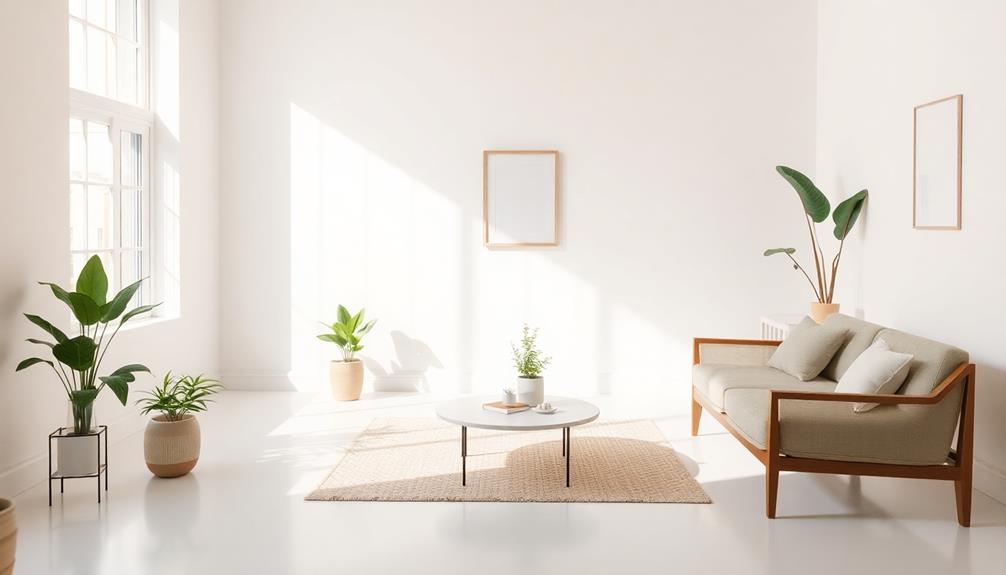
How can you create a more relaxing environment in your home? Start by decluttering for clear energy. Clutter can create chaos and hinder relaxation, so it's crucial to remove unnecessary items. By doing this, you not only improve your physical space but also promote emotional stability.
A clean environment fosters mental clarity, enhancing well-being and allowing you to enjoy a tranquil atmosphere. Consider adding vibrant colors and intricate patterns through Indonesian decorative pillows to elevate the aesthetic while maintaining comfort.
Next, organize your belongings. Utilize effective storage solutions to keep your space tidy, making it easier to access and appreciate the items that truly matter. This organization helps maintain positive energy flow, creating a harmonious space that promotes relaxation and high vibrations.
Don't forget to create open areas for activities and movement. This encourages energy flow and helps cultivate a serene and inviting retreat.
Choose Soothing Color Palettes

Choosing soothing color palettes is essential for creating a relaxing retreat in your home. Soft, neutral colors like cream, pale yellow, and peach foster relaxation and establish a serene environment. Calming shades, such as blues and greens, evoke tranquility, making them perfect for spaces where you unwind. While bright colors can energize, use them sparingly to maintain a calming atmosphere.
To help you select the best colors for your retreat, here's a quick reference table:
| Color Type | Description |
|---|---|
| Neutral Colors | Promote relaxation and create a serene environment |
| Calming Shades | Associated with tranquility, ideal for rest |
| Earth Tones | Foster grounding and stability for peace |
Incorporating these soothing color palettes will enhance your space, promoting balance and harmony. Earth tones, particularly browns and soft greens, can greatly contribute to a sense of grounding and stability. By thoughtfully choosing your colors, you can transform any room into a haven of relaxation, aligning with the principles of Feng Shui to create a truly inviting retreat.
Optimize Lighting for Comfort
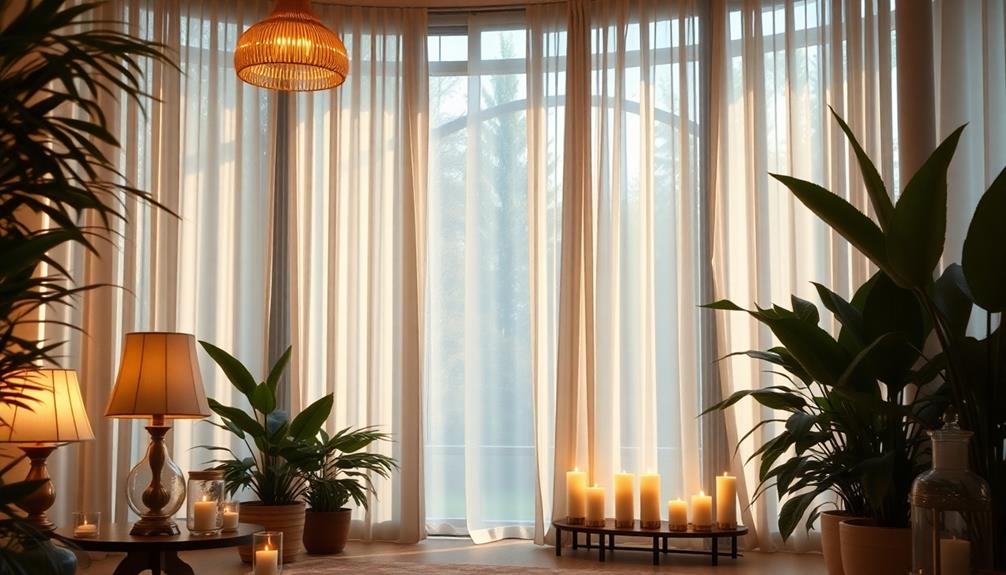
To create a truly relaxing retreat, focus on warm lighting that makes you feel cozy and secure.
Incorporating natural materials like wood and stone can enhance the warmth of your space, echoing the essence of Balinese design characteristics.
Don't forget to maximize natural light during the day by keeping your windows clear, as sunlight can greatly boost your mood.
Warm Light Benefits
Creating a cozy atmosphere in your retreat is all about the right lighting, and warm light plays an essential role in achieving that comfort. Warm lighting, like yellow bulbs in lamps, helps promote relaxation, making your space feel soothing rather than harsh. This gentle illumination fosters an inviting atmosphere, enhancing your sense of security and tranquility.
Incorporating natural materials like wood and textiles can further complement the warmth of your lighting, echoing the principles of traditional Indonesian style home decor.
To optimize your lighting for comfort, consider layering different sources—think table and floor lamps. This setup allows for adjustable brightness, so you can easily switch from bright light for tasks to soft, ambient lighting for unwinding in the evening. Adding dimmer switches further enhances this flexibility, letting you create a peaceful environment tailored to your mood.
While you focus on warm light, don't forget the importance of natural light during the day. It boosts energy throughout your space and elevates your mood. Maximize window access and keep curtains open to let the sun's warmth flow in, complementing your warm lighting strategy.
Natural Light Importance
Harnessing the power of natural light can dramatically elevate the comfort and ambiance of your retreat. In designs that embrace modern tropical aesthetics, the integration of large windows helps to blend indoor and outdoor environments, fostering a serene atmosphere.
When you incorporate natural light into your space, you not only boost your mood but also enhance your energy levels, creating a positive flow of energy throughout the room. This sense of balance can improve your overall well-being and promote relaxation.
To optimize the benefits of natural light, consider these tips:
- Install large windows or skylights to maximize sunlight intake, fostering an open atmosphere.
- Use sheer window treatments that let sunlight filter in while maintaining privacy, creating a cozy environment.
- Strategically position mirrors to reflect natural light, amplifying brightness and uplifting the space.
- Arrange furniture to embrace light sources, ensuring that every corner benefits from the glow of the sun.
Incorporate Natural Elements
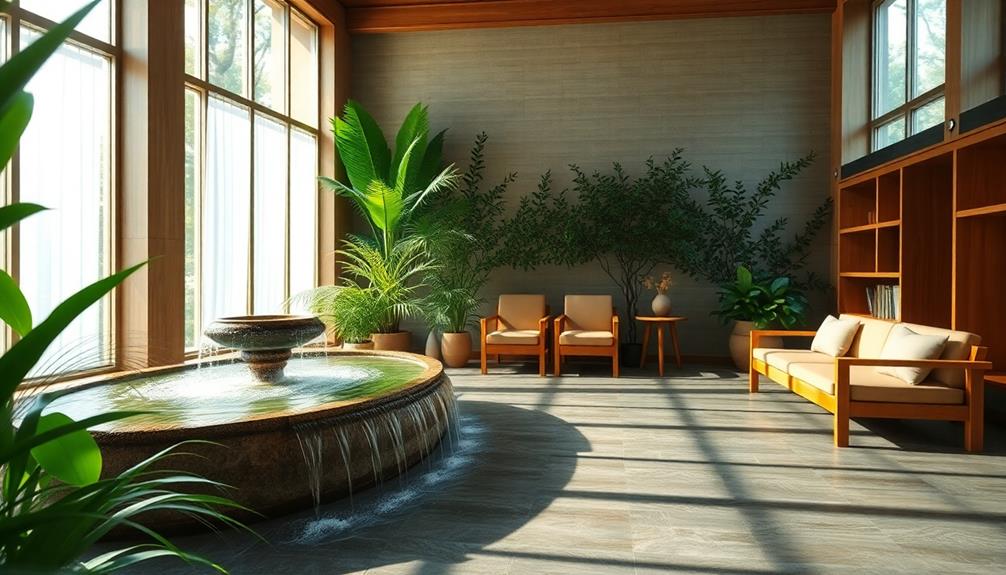
Incorporating natural elements into your retreat can transform the space into a sanctuary of relaxation. By introducing plants, natural materials, and water features, you can create a peaceful environment that enhances your overall well-being. Here's how you can do it:
| Element | Benefits | Tips |
|---|---|---|
| Large Plants | Improve air quality, create grounding energy | Position them near windows for sunlight |
| Natural Materials | Promote a soothing atmosphere, connect you to nature | Use wood, stone, and wool in decor |
| Water Features | Introduce calming sounds, enhance positive energy | Consider a small fountain for serenity |
Position plants and flowers strategically to attract positive energy and invigorate the space. Fresh flowers can add vibrancy, while a view of nature or nature-inspired artwork fosters a connection to the outdoors. Water elements, like a small fountain, introduce soothing sounds that create a serene ambiance, enhancing the flow of positive energy (Chi). By thoughtfully incorporating these natural elements, you can cultivate a soothing atmosphere that supports relaxation and tranquility in your retreat.
Arrange Furniture Mindfully

After you've brought natural elements into your retreat, the next step is to arrange your furniture mindfully. By thoughtfully positioning your pieces, you can create a space that nurtures positive energy and enhances the overall flow in the room. Incorporating decor like traditional artistry through Indonesian masks can further enrich the ambiance with vibrant colors and cultural significance.
Here are a few tips to keep in mind:
- Position larger furniture against solid walls for stability and support.
- Use rounded-edge furniture to encourage smooth energy flow.
- Arrange seating in a circular or semi-circular formation to foster conversation and connection.
- Maintain proportionality between furniture and room size for a balanced environment.
Consider how each piece serves a clear purpose, contributing to the harmony of the space.
When arranging your furniture, ascertain that movement is easy and unobstructed, creating a sense of freedom and comfort. This approach not only enhances the energy in the room but also promotes relaxation.
Create Calm Pathways

To create calm pathways in your space, guarantee they're free of obstacles for smooth movement and a natural flow of energy.
Arranging your furniture in a way that promotes openness can mirror the traditional Rumah Adat design, which emphasizes elevated structures and community space.
Make it easy to navigate without feeling crowded.
Regularly declutter these areas and consider adding natural elements like plants to enhance tranquility and connect with nature.
Clear Pathway Design
Creating clear pathways in your home is essential for fostering a calming environment. An unobstructed design promotes free movement and enhances energy flow, allowing Chi to circulate smoothly throughout your space.
Incorporating elements such as a Face Indonesian Decor Mask can further enhance the aesthetic appeal while celebrating rich cultural heritage. By carefully arranging your furniture and decor, you can create a relaxing atmosphere that feels open and inviting.
To achieve effective clear pathway design, consider these tips:
- Position furniture away from walkways to avoid feelings of confinement.
- Use natural elements like plants or decorative screens to subtly define pathways while maintaining openness.
- Avoid placing large furniture pieces directly in the line of sight to prevent visual blockages.
- Regularly declutter pathways to maintain a clean and orderly environment, supporting mental clarity and relaxation.
Encourage Natural Flow
Encouraging natural flow in your home enhances the calming atmosphere established through clear pathways. To promote relaxation, guarantee that these pathways are unobstructed, allowing energy (Chi) to move freely throughout the room.
When arranging furniture, create inviting pathways that encourage movement and interaction, avoiding any blockages that could lead to stagnant energy. Consider incorporating vibrant floral displays inspired by Indonesian wedding decor ideas to add a touch of nature and color, fostering a more serene environment.
Be mindful of large furniture pieces; placing them directly in the line of sight of doorways can disrupt the natural flow and create feelings of confinement. Instead, opt for soft, rounded furniture designs that enhance comfort and facilitate a gentle flow of energy in your home.
Incorporating natural elements, such as plants or decorative screens, can visually guide movement while maintaining open pathways. These elements also contribute to a calming ambiance, promoting a sense of peace and relaxation.
Personalize Your Space

Personalizing your space can transform it into a true reflection of who you are. Surround yourself with personal items, like family photos or artwork, that evoke positive memories and emotions. This creates a comforting atmosphere that promotes relaxation and tranquility.
Incorporate sentimental objects that tell your story or represent your aspirations to enhance emotional connection and foster a sense of belonging. Consider adding unique decor pieces, such as Indonesian decor masks, which not only enhance aesthetic appeal but also serve as conversation starters that celebrate cultural heritage.
To truly personalize your space, consider the following:
- Choose colors and textures that resonate with you, ensuring a harmonious environment.
- Infuse your environment with favorite books or travel souvenirs to inspire joy and creativity.
- Regularly reassess your decor by incorporating seasonal changes or new personal items to maintain ideal energy flow.
- Create a dedicated corner for mindfulness practices, like meditation or reading, to enhance your sense of peace.
Frequently Asked Questions
What Is the Feng Shui Rule for Bedrooms?
In Feng Shui, position your bed in the Command Position for security and visibility. Choose soft-edged furniture, calming colors, and limit electronics to create a serene space that promotes restful sleep and relaxation.
What Colors Should Be Avoided in Feng Shui?
You should avoid overly vibrant colors, heavy dark shades, excessive reds, and clashing hues in your space. These colors can create discomfort, unease, and disrupt the calm atmosphere you're aiming to achieve.
What Is the Feng Shui Room Theory?
The Feng Shui Room Theory focuses on arranging your space to enhance energy flow. By considering each room's purpose, decluttering, and personalizing your decor, you create an environment that promotes balance, relaxation, and well-being.
What Is Bad Feng Shui for a Living Room?
Bad feng shui for your living room includes overcrowding with furniture, harsh lighting, and clutter. Avoid positioning furniture facing away from the entrance, and be cautious with mirrors to maintain positive energy and tranquility.
Conclusion
By embracing these feng shui tricks, you're not just transforming a room; you're crafting your personal oasis of tranquility! Imagine stepping into a space so serene that stress evaporates like a puff of smoke, leaving only bliss behind. With decluttering, soothing colors, and natural elements, you'll find yourself floating on clouds of calm every time you enter. So go ahead, turn your home into a haven—because who wouldn't want to live in a paradise of relaxation?
-

 Mom4 months ago
Mom4 months agoHeartfelt Poems for Your Daughter’s Birthday
-

 Mom4 months ago
Mom4 months agoHappy Birthday Religious Wishes and Blessings
-

 Mom4 months ago
Mom4 months agoHappy 65th Birthday: Celebrate Your Special Day!
-

 Mom4 months ago
Mom4 months agoHappy Birthday in Heaven from Daughter: Remembering You
-

 Mom4 months ago
Mom4 months agoCelebrating 60 Years: Happy 60th Birthday Wishes
-

 Mom4 months ago
Mom4 months ago62nd Birthday Quotes for Mom: Celebrate Her Special Day
-

 Mom4 months ago
Mom4 months agoCelebrate a Joyous Happy 70th Birthday Milestone!
-

 Mom4 months ago
Mom4 months agoHappy 61st Birthday: Celebrate This Special Milestone

















